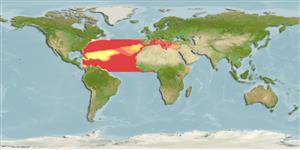Issue
This species is often confused with Nezumia aequalis (Günther, 1878).
Environment: milieu / climate zone / depth range / distribution range
Ecologia
marino batipelagico; non migratori; distribuzione batimetrica 130 - 3200 m (Ref. 3587), usually 450 - 730 m (Ref. 1371). Deep-water; 43°N - 4°N, 81°W - 36°E
Atlantic Ocean: North Atlantic south to the northern part of the Gulf of Guinea in the east, into the Mediterranean Sea, and north of Straits of Florida in the west.
Length at first maturity / Size / Peso / Age
Maturity: Lm 15.0, range 13 - 17 cm
Max length : 36.0 cm TL maschio/sesso non determinato; (Ref. 3587)
Spine dorsali (totale) : 2; Spine anali: 0. Snout short, bluntly acute; terminal scute broad, blunt; ventral surface of snout without scales posteriorly including most of suborbital, mandible mostly naked, pores prominent on head. Pyloric caeca 22 to 29. Body scales with slender, conical, slanting spinules arranged in converging rows. Color in alcohol brownish, paler on head, with violet tinge on abdomen, some silvery reflections; fins pale to blackish; first dorsal fin uniformly blackish; mouth and gill cavity mostly black.
Most numerous at 450 to 730 m in the open Atlantic and at 500 to 800 m in the Mediterranean. Feeds on small crustaceans (copepods, amphipods, decapods, mysids, etc.) and polychaetes (Ref. 1371)
Life cycle and mating behavior
Maturità | Riproduzione | Deposizione | Uova | Fecundity | Larve
Cohen, D.M., T. Inada, T. Iwamoto and N. Scialabba, 1990. FAO species catalogue. Vol. 10. Gadiform fishes of the world (Order Gadiformes). An annotated and illustrated catalogue of cods, hakes, grenadiers and other gadiform fishes known to date. FAO Fish. Synop. 125(10). Rome: FAO. 442 p. (Ref. 1371)
IUCN Red List Status (Ref. 130435: Version 2024-2)
Threat to humans
Harmless
Human uses
Pesca: scarso interesse commerciale
Strumenti
Special reports
Download XML
Fonti Internet
Estimates based on models
Preferred temperature (Ref.
123201): 6.3 - 14, mean 12.3 °C (based on 169 cells).
Phylogenetic diversity index (Ref.
82804): PD
50 = 0.5000 [Uniqueness, from 0.5 = low to 2.0 = high].
Bayesian length-weight: a=0.00129 (0.00076 - 0.00217), b=3.14 (2.99 - 3.29), in cm total length, based on LWR estimates for this species & (Sub)family-body (Ref.
93245).
Trophic level (Ref.
69278): 3.2 ±0.34 se; based on food items.
Generation time: 6.9 ( na - na) years. Estimated as median ln(3)/K based on 1
growth studies.
Resilienza (Ref.
120179): Medio, tempo minimo di raddoppiamento della popolazione 1.4 - 4.4 anni (K=0.10-0.16; tmax=9).
Fishing Vulnerability (Ref.
59153): Moderate to high vulnerability (48 of 100).
Nutrients (Ref.
124155): Calcium = 28.8 [7.6, 70.7] mg/100g; Iron = 0.294 [0.121, 0.874] mg/100g; Protein = 16.9 [15.0, 18.7] %; Omega3 = 0.119 [0.042, 0.315] g/100g; Selenium = 22.1 [6.4, 62.2] μg/100g; VitaminA = 31.3 [3.4, 282.7] μg/100g; Zinc = 0.713 [0.371, 1.463] mg/100g (wet weight);
